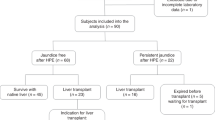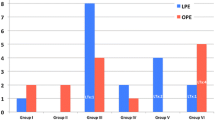Abstract
Background
Biliary atresia (BA) is a serious liver disease with uncertain prognosis. The objective of this study was to investigate prognostic values of the >20 % decrease in serum total bilirubin (TB) at 7th day post-op regarding early outcome and 5-year survival with native liver in BA.
Methods
Biliary atresia patients undergoing Kasai operation between 2000 and 2014 were reviewed. The ratio of serum TB at 7th day post-op to pre-op TB levels (TB7/TB0) was calculated for every patient. TB7/TB0 ratio of <0.8 indicated the >20 % decrease in serum TB. At 6th month following Kasai operation, outcome of BA patients were categorized into good outcome (TB < 2 mg % or clinically jaundice free) and poor outcome (TB > 2 mg % or clinically jaundice). For outcome analysis, logistic regression was used. For survival analysis, Cox regression was applied.
Results
There were 133 BA patients (M:F = 68:65) undergoing Kasai operation. Median age at surgery was 79 days. BA patients with TB7/TB0 ratio of <0.8 were found in 38 %. Outcome at 6-month post-op could be evaluated in 126 patients (good: poor = 68:58). The 1-, 3- and 5-year survival rates with native livers were 85, 70 and 65 %, respectively. The median overall survival with native livers was 164 months. Median follow-up time was 87 months. Logistic regression showed that gender and age at operation were not significant factors impacting on early outcome (p > 0.05). However, TB7/TB0 ratio of <0.8 was an independent factor for good outcome (Odds ratio = 3.0, p = 0.006). Cox regression analysis demonstrated that 5-year survival rate was significantly correlated with TB7/TB0 ratio of <0.8 (HR = 0.46, 95 % CI 0.23–0.91, p = 0.025) and outcome at 6th month post-op (HR = 0.05, 95 % CI 0.01–0.15, p < 0.001).
Conclusions
The >20 % decrease in serum TB at 7th day post-Kasai is a predictor for good outcome. BA patients with TB7/TB0 of <0.8 had 5-year survival with native livers significantly higher than those with the ratio of >0.8.




Similar content being viewed by others
References
Kasai M (1983) Advances in treatment of biliary atresia. Jpn J Surg 13:265–276
Kelly DA, Davenport M (2007) Current management of biliary atresia. Arch Dis Child 92:1132–1135
Schreiber RA, Barker CC, Roberts EA et al (2007) Biliary atresia: the Canadian experience. J Pediatr 151:659–665
Sookpotarom P, Vejchapipat P, Chittmittrapap S et al (2006) Short-term results of Kasai operation for biliary atresia: experience from one institution. Asian J Surg 29:188–192
Nio M, Wada M, Sasaki H, Tanaka H (2015) Effects of age at Kasai portoenterostomy on the surgical outcome: a review of the literature. Surg Today 45:813–818
Nio M, Sasaki H, Wada M, Kazama T, Nishi K, Tanaka H (2010) Impact of age at Kasai operation on short- and long-term outcomes of type III biliary atresia at a single institution. J Pediatr Surg 45:2361–2363
Rodeck B, Becker AC, Gratz KF, Petersen C (2007) Early predictors of success of Kasai operation in children with biliary atresia. Eur J Pediatr Surg 17:308–312
Goda T, Kawahara H, Kubota A et al (2013) The most reliable early predictors of outcome in patients with biliary atresia after Kasai’s operation. J Pediatr Surg 48:2373–2377
Koga H, Wada M, Nakamura H et al (2013) Factors influencing jaundice-free survival with the native liver in post-portoenterostomy biliary atresia patients: results from a single institution. J Pediatr Surg 48:2368–2372
Chung PH, Wong KK, Tam PK (2015) Predictors for failure after Kasai operation. J Pediatr Surg 50:293–296
Suominen JS, Lampela H, Heikkila P, Lohi J, Jalanko H, Pakarinen MP (2015) APRi predicts native liver survival by reflecting portal fibrogenesis and hepatic neovascularization at the time of portoenterostomy in biliary atresia. J Pediatr Surg 50:1528–1531
Vejchapipat P, Passakonnirin R, Sookpotarom P, Chittmittrapap S, Poovorawan Y (2007) High-dose steroids do not improve early outcome in biliary atresia. J Pediatr Surg 42:2102–2105
Laurent J, Gauthier F, Bernard O et al (1990) Long-term outcome after surgery for biliary atresia. Study of 40 patients surviving for more than 10 years. Gastroenterology 99:1793–1797
Otte JB, de Ville de Goyet J, R Reding et al (1994) Sequential treatment of biliary atresia with Kasai portoenterostomy and liver transplantation: a review. Hepatology 20:41S–48S
Kasai M, Mochizuki I, Ohkohchi N, Chiba T, Ohi R (1989) Surgical limitation for biliary atresia: indication for liver transplantation. J Pediatr Surg 24:851–854
Chardot C, Carton M, Spire-Bendelac N et al (2001) Is the Kasai operation still indicated in children older than 3 months diagnosed with biliary atresia? J Pediatr 138:224–228
Chardot C, Carton M, Spire-Bendelac N, Le Pommelet C, Golmard JL, Auvert B (1999) Prognosis of biliary atresia in the era of liver transplantation: French national study from 1986 to 1996. Hepatology 30:606–611
Serinet MO, Wildhaber BE, Broue P et al (2009) Impact of age at Kasai operation on its results in late childhood and adolescence: a rational basis for biliary atresia screening. Pediatrics 123:1280–1286
Superina R, Magee JC, Brandt ML et al (2011) The anatomic pattern of biliary atresia identified at time of Kasai hepatoportoenterostomy and early postoperative clearance of jaundice are significant predictors of transplant-free survival. Ann Surg 254:577–585
Shneider BL, Brown MB, Haber B et al (2006) A multicenter study of the outcome of biliary atresia in the United States, 1997 to 2000. J Pediatr 148:467–474
Baruah RR, Bhatnagar V, Agarwala S, Gupta SD (2015) Correlation of pre- and post-operative liver function, duct diameter at porta hepatis, and portal fibrosis with surgical outcomes in biliary atresia. J Indian Assoc Pediatr Surg 20:184–188
Author information
Authors and Affiliations
Corresponding author
Ethics declarations
Conflict of interest
The authors declare that the authors have no conflict of interest.
Rights and permissions
About this article
Cite this article
Chusilp, S., Sookpotarom, P., Tepmalai, K. et al. Prognostic values of serum bilirubin at 7th day post-Kasai for survival with native livers in patients with biliary atresia. Pediatr Surg Int 32, 927–931 (2016). https://doi.org/10.1007/s00383-016-3951-9
Accepted:
Published:
Issue Date:
DOI: https://doi.org/10.1007/s00383-016-3951-9




